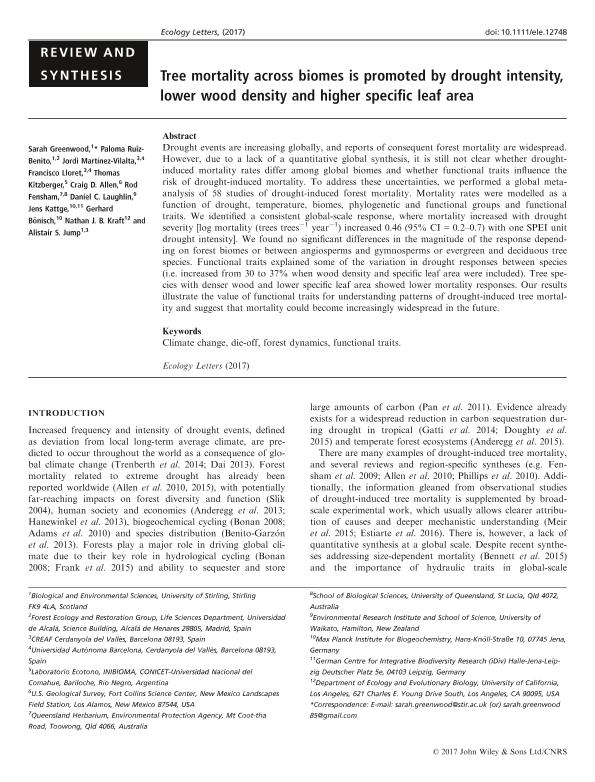Mostrar el registro sencillo del ítem
dc.contributor.author
Greenwood, Sarah
dc.contributor.author
Ruiz Benito, Paloma
dc.contributor.author
Martínez Vilalta, Jordi
dc.contributor.author
Lloret, Francisco
dc.contributor.author
Kitzberger, Thomas

dc.contributor.author
Allen, Craig D.
dc.contributor.author
Fensham, Rod
dc.contributor.author
Laughlin, Daniel C.
dc.contributor.author
Kattge, Jens
dc.contributor.author
Bönisch, Gerhard
dc.contributor.author
Kraft, Nathan J. B.
dc.contributor.author
Jump, Alistair S.
dc.date.available
2018-09-06T15:13:44Z
dc.date.issued
2017-04
dc.identifier.citation
Greenwood, Sarah; Ruiz Benito, Paloma; Martínez Vilalta, Jordi; Lloret, Francisco; Kitzberger, Thomas; et al.; Tree mortality across biomes is promoted by drought intensity, lower wood density and higher specific leaf area; Wiley Blackwell Publishing, Inc; Ecology Letters; 20; 4; 4-2017; 539-553
dc.identifier.issn
1461-023X
dc.identifier.uri
http://hdl.handle.net/11336/58512
dc.description.abstract
Drought events are increasing globally, and reports of consequent forest mortality are widespread. However, due to a lack of a quantitative global synthesis, it is still not clear whether drought-induced mortality rates differ among global biomes and whether functional traits influence the risk of drought-induced mortality. To address these uncertainties, we performed a global meta-analysis of 58 studies of drought-induced forest mortality. Mortality rates were modelled as a function of drought, temperature, biomes, phylogenetic and functional groups and functional traits. We identified a consistent global-scale response, where mortality increased with drought severity [log mortality (trees trees−1 year−1) increased 0.46 (95% CI = 0.2–0.7) with one SPEI unit drought intensity]. We found no significant differences in the magnitude of the response depending on forest biomes or between angiosperms and gymnosperms or evergreen and deciduous tree species. Functional traits explained some of the variation in drought responses between species (i.e. increased from 30 to 37% when wood density and specific leaf area were included). Tree species with denser wood and lower specific leaf area showed lower mortality responses. Our results illustrate the value of functional traits for understanding patterns of drought-induced tree mortality and suggest that mortality could become increasingly widespread in the future.
dc.format
application/pdf
dc.language.iso
eng
dc.publisher
Wiley Blackwell Publishing, Inc

dc.rights
info:eu-repo/semantics/openAccess
dc.rights.uri
https://creativecommons.org/licenses/by-nc-sa/2.5/ar/
dc.subject
Climate Change
dc.subject
Die-Off
dc.subject
Forest Dynamics
dc.subject
Functional Traits
dc.subject.classification
Otras Ciencias Biológicas

dc.subject.classification
Ciencias Biológicas

dc.subject.classification
CIENCIAS NATURALES Y EXACTAS

dc.title
Tree mortality across biomes is promoted by drought intensity, lower wood density and higher specific leaf area
dc.type
info:eu-repo/semantics/article
dc.type
info:ar-repo/semantics/artículo
dc.type
info:eu-repo/semantics/publishedVersion
dc.date.updated
2018-08-31T13:48:55Z
dc.journal.volume
20
dc.journal.number
4
dc.journal.pagination
539-553
dc.journal.pais
Reino Unido

dc.journal.ciudad
Londres
dc.description.fil
Fil: Greenwood, Sarah. University Of Stirling; Reino Unido
dc.description.fil
Fil: Ruiz Benito, Paloma. Universidad de Alcalá; España. University Of Stirling; Reino Unido
dc.description.fil
Fil: Martínez Vilalta, Jordi. Consejo Superior de Investigaciones Científicas. Centre de Recerca Ecológica I Aplicacions Forestals; España. Universitat Autònoma de Barcelona; España
dc.description.fil
Fil: Lloret, Francisco. Universitat Autònoma de Barcelona; España. Consejo Superior de Investigaciones Científicas. Centre de Recerca Ecológica I Aplicacions Forestals; España
dc.description.fil
Fil: Kitzberger, Thomas. Consejo Nacional de Investigaciones Científicas y Técnicas. Centro Científico Tecnológico Conicet - Patagonia Norte. Instituto de Investigaciones en Biodiversidad y Medioambiente. Universidad Nacional del Comahue. Centro Regional Universidad Bariloche. Instituto de Investigaciones en Biodiversidad y Medioambiente; Argentina
dc.description.fil
Fil: Allen, Craig D.. United States Geological Survey; Estados Unidos
dc.description.fil
Fil: Fensham, Rod. The University Of Queensland; Australia. Queensland Herbarium; Australia. University of Queensland; Australia
dc.description.fil
Fil: Laughlin, Daniel C.. University Of Waikato; Nueva Zelanda
dc.description.fil
Fil: Kattge, Jens. German Centre for Integrative Biodiversity Research; Alemania. Max Planck Institut Fur Biogeochemie Jena; Alemania
dc.description.fil
Fil: Bönisch, Gerhard. Max Planck Institut Fur Biogeochemie Jena; Alemania
dc.description.fil
Fil: Kraft, Nathan J. B.. University of California at Los Angeles; Estados Unidos
dc.description.fil
Fil: Jump, Alistair S.. University Of Stirling; Reino Unido. Consejo Superior de Investigaciones Científicas. Centre de Recerca Ecológica I Aplicacions Forestals; España
dc.journal.title
Ecology Letters

dc.relation.alternativeid
info:eu-repo/semantics/altIdentifier/doi/https://dx.doi.org/10.1111/ele.12748
dc.relation.alternativeid
info:eu-repo/semantics/altIdentifier/url/https://onlinelibrary.wiley.com/doi/abs/10.1111/ele.12748
Archivos asociados
